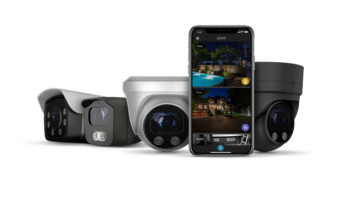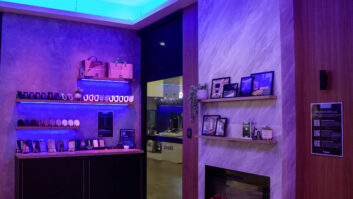The systems integrator, the builder, the architect, and the interior designer. Theyre all in it together. What was once viewed as a loose conglomeration of professionals working toward a common goala successful project completionhas now evolved into a group whose boundaries overlap, mainly into systems integration to the benefit of everyone concerned, including the client.
Utz Baldwin, president of AD Systems in Houston, noted a radical shift in the past 12 to 18 months toward an increased desire on the part of industry partners to better understand more about systems design and the integration process. Consumers are asking their builders, architects, and designers to provide them with what is often the most expensive technology purchases of their lives, and industry partners are chomping at the bit for education and a better understanding of what technology can do for their clients, said Baldwin, who is also CEDIAs vice president and Industry Events and Outreach Council chair. They want to be able to hold an educated conversation with clients to demonstrate the value of the technology, and theyre greeting us with open arms.
]
Baldwin credits the upsurge in partner interest with CEDIAs active grassroots and national quest to strengthen partner relationships. CEDIA is building a pool of certified or registered outreach volunteers to deliver credits to designers and architects, he said. We have several AIA-approved courses, and any CEDIA member has access to them by attending an ROI (Registered Outreach Instructor) course. We train the trainers, giving them PowerPoint presentations and instructions. I currently have several hundred volunteers putting time into CEDIA Outreach.
Baldwin points to the success of the recent Custom Builder Symposium, noting that builders have slightly different needs from system integrators especially when it comes to issues like revenue sharing and whether or not electronics costs should be rolled into mortgages, while the two segments can find common ground on cash-flow and employee issues.
Similarly, systems designers and integrators share a near-identical historical path with the American Society of Interior Designers (ASID). He also highlighted an association that is little known to CEDIA members. One of the newest groups is CORA, the Congress of Residential Architects. This is targeting younger members, is up-and-coming, and I think will make an impact over the next decade. And if you look at the industry as a whole, youll see that our clients, too, are becoming younger, smarter and faster, and they expect performance.
Penetrating the multiple layers of NAHB can be a time-consuming task, said Andy Willcox, president, ProLine Integrated Systems Inc., Highland Park, Illinois. Instrumental in launching CEDIAs Electronic Lifestyles Forum, Willcox has been involved with the development of CEDIAs outreach process for six years. Its targets, he said, are ASID and AIA in addition to the National Association of Home Builders. NAHB has some 205,000 members, 70,000 of whom are builders, in autonomous national, regional, and local chapters, he said. There are approximately 2,500 members on their board of directors.
There are synergies, Willcox said, between builders and integrators because builders realize that technology is becoming pervasive. The consumer will get the systems one way or another and it makes sense to builders to discern the methods in which they can differentiate themselves by providing technology at various levels, including custom production builders who need our technology as part of the core of their custom homes. The challenge comes in keeping builders and the other trades apprised of evolving technologies and how costs have come down to a level that is highly approachable for the consumer.
As a creative discipline, architects dont have the same driver, he added. For them, technology is not so much a profit issue as it is a way to enhance their craft by making a project more interesting and meeting their clients expectations. There are, of course, design-build groups, hybrids that are looking for profit, and everyone is looking for value.
ASID was the most reticent organization to accept technology because its members focus on interior finishes and aesthetics. Designers dont have the momentum drawing them to our technology, but they have a huge interest, Willcox said. We initiated a strategic partners opportunity, in February at the Electronic Lifestyles Expo in San Francisco, with about 250 people in attendance. It was a kind of litmus test pre-empting the EXPO in Las Vegas in April 2007, and we expect much greater attendance then.
The only way to stay on top is to be in constant communication with the other trades, said Jonas Buzzerio, vice president and systems designer, e-home, Ridgefield, New Jersey. Theres a higher level of detail involved in residential projects in the New York metro area such as room changes that have to be documented. If a speaker has to be moved, typically the architect makes a sketch, which then has to be priced by the contractor. Interior and lighting designers require the same coordination, and lighting design often changes by the time a client moves in.
Most architects realize that they have to get the integrator involved somewhat early, Buzzerio said, so contractors can bid on electrical, prewire, or lighting control as soon as possible. Servicing the contractors as well can pay off, he said. Some contractors charge a percentage on top of our contract and get paid by the client for coordinating the system design and installation. But if you dont meet with them periodically, things will fall through the cracks and devices will be located where you didnt anticipate them. So if you have a good working relationship with them, things will go smoothly and they will want you on their next project.
Interacting effectively with the trades is not only necessary for systems integrators but for consultants who work with architects and interior designers. Jetson Systems in San Francisco is a technology consulting firm that specializes in the design and programming of electronic control systems. We work in partnership with custom installers, architects, interior designers, builders, developers, and end-users alike to design systems that integrate seamlessly into any environment and offer the highest level of flexibility well into the future, said Jetson president Austin Lowery.
A recent Jetson project illustrates the collaboration effort between multiple trades and Jetsons consulting services. The client, a technophobe, purchased a large home overlooking the San Francisco Bay with views of Alcatraz. Initially apprehensive about installing an integrated control system, the client was convinced by Lowery to visit a recently completed Jetson job where he was able to experience a live system. After spending a short time playing with Jetsons intuitive interfaces, the client shook Lowerys hand and said, Even I can use this system. Congratulations, youve got the job.
Jetson was hired as a consultant to design and program the integrated systems to ensure simple control and intuitive navigation, working with Engineered Environments in Oakland, to handle all wiring and to provide and install all the equipment. The company also worked closely with the architect Sutton Suzuki and the builder IR Hadley on several custom features in the home. The reason for its success emanates from Jetsons joint effort with architects, Lowery said.
It is critical to work closely with the architect from the early planning stages to make sure that all details are considered. Space for system equipment, access for wiring, and power are just a few of the things that architects need to plan for when designing a house with an integrated system.
Lowery found that many builders and architects have little idea what to expect when considering implementing this type of technology. They appreciate having a resource to call when they have questions, he said. We are working a lot with architects in early stages to ensure that space is allocated and the wiring is in place for future systems.
Hands-on experience gave Jack Borenstein, president, Ultimate Sound & Installations in Long Island City, New York, an edge in dealing with members of the other trades now. Ive done electrical, plumbing, carpentry, and marble, tile, and window shade installation, he said. Just knowing how things are built and understanding the flow of steps needed to implement these things is a great help.
Borenstein said that observing the craftsman in the various disciplines allows him to better explain preparation and installation of systems to his staff or anyone in the field, demystifying what he said is voodoo to the average guy. I once had a GC that was under the impression that if cables were chopped into a wall and then plastered over with plaster of Paris, the heat generated would melt the cables, he said. He didnt want anything to do with it. The heat generated by plaster of Paris, although warm to the touch, doesnt generate enough heat to melt the plastic jacket on cablesmyth busted.
Its important to take a lesson from integrators mistakes, from colleagues who have stepped onto projects only to antagonize the other trades. His advice: Under-promise and over-deliver. Dont create drama or problems. Be the can-do guy. Offer solutions to questions or problems. But know what youre talking about.
Before you say yes, he advised, do your research and due diligence. Check with more than one manufacturer or engineer about whether or not you can bend the rules of physics. It may be easier for the GC to install that in-wall subwoofer without the big rough-in box, but it may cause a problem for the clients next-door neighbor because the bass is leaking into his space. You certainly do not want to go in there later to announce that they now need to install a 65-inch high x 14-inch wide rough-in box after they just spent $20K faux-finishing the wall.
The more you educate the other trades, the more they will trust and rely upon you, Borenstein said. If the architect and interior designer feel that youre not just out to sell the client as much as you can, they will feel more comfortable recommending you to all their present and future clients, bringing you into the projects not after the walls are all closed-up but during the design stage so you have plenty of time to devote to it.
The bottom line: Always retain document copies for your job binder so if and when you need to prove something, perhaps in a court of law, youre covered, he advised. In other words, CYB, Cover Your Bootie.
Karen Mitchell is a freelance writer in Boulder, CO.






